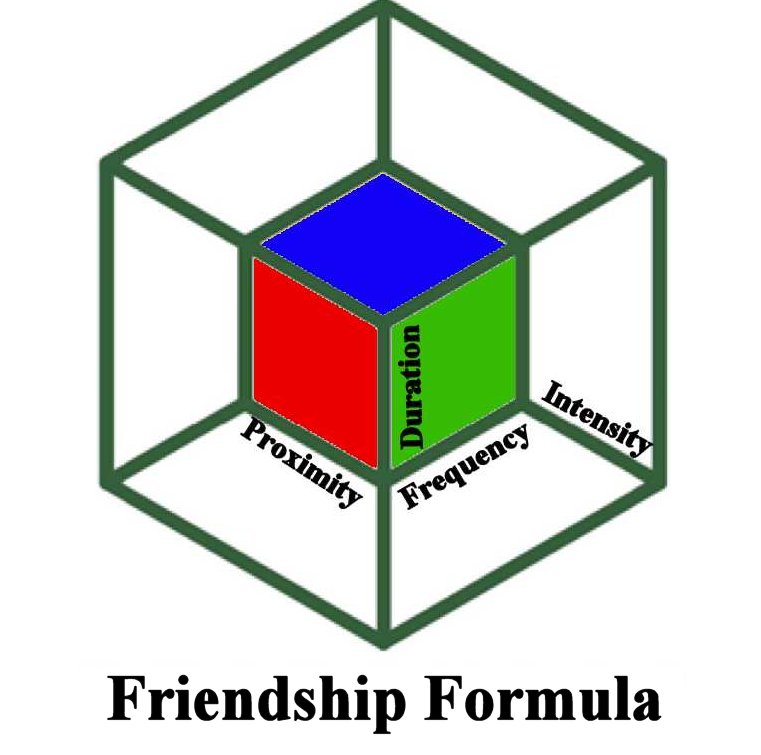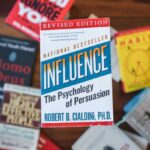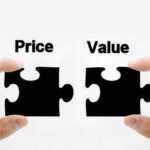The effects of the friendship formula are the subject of many Hollywood movies. Consider this classic movie plot. Two people meet. They have nothing in common and make it clear that they do not like each other. Then they are placed in a situation where they are forced to work together. At first, they do not even speak to each other and by the end of the movie are either fast friends or romantic partners.
When it comes to the Know-Like-Trust continuum, defined by John Jantsch in his book “Duct Tape Marketing”, after a prospect becomes aware of you and your business, the next step in the sales process is to get them to like you. That is where the friendship formula comes in.
According to former FBI agent Jack Shafer who taught behavioral analysis for the FBI and wrote the book “The Like Switch”, there is a friendship formula that consists of four basic building blocks. These blocks are:
- Proximity
- Frequency
- Duration
- Intensity
Being dyslexic, I often see concepts as visual images and the friendship formula is no different. Proximity, frequency, and duration make up the three dimensions of a cube, and intensity represents the overall size of the cube. The bigger the volume of the cube, the greater the prospect will like you.
Proximity
Proximity is the distance between you and another individual, and your exposure to that individual over time. Just being in the same vicinity as your prospect is critical to the development of any relationship. People that share physical space are more likely to like each other even if no words are spoken.
The key to the power of proximity is that it must take place in a nonthreatening environment. If a person feels threatened by someone being too close, they go “shields up” and take evasive action to move away from that person. Keeping a safe distance at first prevents others from perceiving us as a threat and thus eliciting a “fight or flight” response.
“Just being in the same vicinity as your recruitment target is critical to the development of a personal relationship. Proximity predisposes your recruitment target to like you and promotes mutual attraction. People who share physical space are more likely to become attracted to one another, even when no words are exchanged.”
Jack Shafer
Another psychological phenomenon that supports the benefit of physical proximity is the mere exposure effect. This states that people tend to prefer things that are more familiar to them. This is the reason businesses run advertisements.
During the pandemic, many people started to work from home and stopped going into the office. As a result, many of these individuals became closer to their family members and less close to their workmates. In comparison, many healthcare workers, who were forced to work more hours, became closer to their fellow workers, often at the expense of their personal relationships.
Research has shown us that the more often someone sees a person, the more pleasant and likable they find that person; so when it comes to sales, consider doing a bit of research on your prospect to see where they might eat lunch, what conferences they might attend, etc. and make plans to visit these same places.
Frequency
Of course, just one nonverbal exposure will not cause a prospect to instantly like you, so we need to add frequency. Frequency is the number of contacts you have with another individual over time. Therefore, you must bump into the prospect on several occasions to increase the chances that the prospect will take a shine to you. You do not even have to make verbal contact with the prospect, simply making eye contact or engaging in other nonverbal communications is all that it takes.
As a small business mentor, I meet many clients. However, there are a handful of clients that I meet on a much more regular basis. Simply by the frequency of our mentoring sessions, we have developed a close friendship. My ability as a mentor to help them shape their business increases with the frequency of our mentoring sessions, as we have more opportunities to build a greater level of trust. Some clients have even become personal friends over the years.
Duration
Proximity and frequency are nothing without duration. Duration is the length of time you spend with another individual over time. As with proximity and frequency, duration does not always need to include verbal communication. Simply spending extended periods of time with a person contributes to duration.
For example, as a sailor on a Coast Guard cutter, I always held a shipmate in higher regard than other sailors on other ships, even if we were in completely different departments and social circles. The ship forced the proximity by the confines of the ship. Because we ate our meals together on the mess deck each day, it also caused frequency of exposure. And because we spent ten weeks at a time at sea, it also accomplished duration. In the end, just being on a ship together created an esprit de corps that made you willing to defend a shipmate’s honor in public even if you didn’t know their name.
As a salesperson, the more time you spend with a prospect, the more connected they feel toward you as an individual. This is one of the reasons that salespeople that embrace the challenger archetype are the top salespeople in their organizations since they devote more time to educating the customers, creating interactions of longer duration.
Recently my wife and I met with two electricians to discuss a kitchen remodeling project. One electrician spent about 20 minutes hearing our design idea, marking a floor plan that we gave him with some notes, said he had everything he needed to put together a bid, and left. The other electrician spent well over an hour with us, taking detailed notes and educating us about solutions we had not known were even options. His bid came in a bit higher than the first electrician. Guess who we went with? If you guessed the second electrician, with whom the duration of the meeting was over three times longer than the first electrician, you would be right because we felt much closer to him as a person which even justified his higher bid.
Intensity
The final and fourth dimension of the friendship formula is intensity. Intensity is how strong you were able to satisfy another person’s psychological and/or physical needs through the use of verbal and nonverbal behaviors. This is the first time that any verbal communication needs to occur.
“When a new stimulus is introduced into a person’s environment, the brain is hardwired to determine if that new stimulus presents a threat or perceived threat. If the new stimulus is judged to be a threat, the person will attempt to eliminate or neutralize it by employing the fight or flight response. If, on the other hand, the new stimulus is not perceived as a threat, then it becomes the object of curiosity. The person wants to learn more about the new stimulus: What is it? Why is it there? Can I use it to my benefit?”
Jack Shafer
When I attempt to explain the role of intensity in building a relationship, I often share the example of when I met my spouse. In the beginning, our dates involved hikes, shooting in the mountains, going to the ocean, etc. After we were married, our dates were relegated to the occasional movie or watching TV where we sat quietly next to each other. After the kids were born, date nights ended as we each had a role to fill raising our two boys at the time. Over time, the intensity of our interaction continued to diminish even though proximity, duration, and frequency remained about the same. Then one day, we took a country dancing lesson. For the next year, we religiously went to our dancing lessons each week as the intensity of our relationship was reignited. Soon, we learned that my wife, who had been told she could no longer have kids, became pregnant again. That is the power of intensity.
As a salesperson, it is not just about showing up and being responsive to the customer. Get involved at a deeper level. Invite them to conferences or sporting events to interject emotion into your relationship. My business banker would often invite me to hockey games in the winter and baseball games in the summer. When I operated my documentation and training business, I would even go on business trips with some of my clients. We shared a flight, stayed in the same hotels, and even ate dinner together. Those customers became social agents of our business and contributed to its growth as they shared our name with many new prospects.
How can you apply the friendship formula to improve your sales process?












